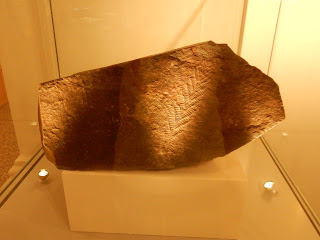This year's ProgPal was held in the city of Leicester. The first afternoon of the conference was host to a couple of workshops, but the first event I attended was the icebreaker later in the evening, which took place at the New Walk Museum.
The paleontology exhibit at this museum is particularly rich in Jurassic marine fossils. Here are the magical jaws of Liopleurodon, poised to clamp down on the head and neck of Muraenosaurus.
As is also visible in the previous photo, many of the fossils were accompanied by small models representing life restorations.
Direct evidence that plesiosaurs ended up on the menu of other sea creatures, in the form of bite marks on some of their bones.
The skull of Rhomaleosaurus.
An ichthyosaur showing off a massive sclerotic ring.
The New Walk Museum is home to some newly-discovered marine reptiles, such as this currently unnamed plesiosaur.
Here is Wahlisaurus, an ichthyosaur that was only described last year.
Naturally, there are also a few dinosaurs on display, including this model of a Neovenator skeleton.
The centerpiece of the hall is the sauropod Cetiosaurus.
Some Ediacaran fossils get in on the act, including several specimens of Charnia.
This is said to be the only solo portrait that David Attenborough has agreed to sit.
The museum has some interesting osteological material of extant species as well, such as this skeleton of a tree kangaroo.
The skull of an Indian (or Ganges) softshell turtle.
The main events of the conference, however, happened on the second day. These were, naturally, the talks and poster presentations. I didn't present anything, given that I had barely begun to do my Master's research by the time abstracts were due. Next year, perhaps.
Even so, the Bristol contingent was well represented (unsurprisingly, considering the size of our research group), accounting for around a quarter of the total number of both attendees and presentations given. (Yes, I counted.) Dare I say, this may have been a double-edged sword in some ways; I noticed that many of us Bristolians (myself included) tended to cluster together during free periods rather than taking the time to meet new people. Nonetheless, I did have quite a few worthwhile interactions with some non-Bristolian delegates, such as meeting with future collaborator Juan Benito Moreno for the first time. I also received some (positive) attention for my continuous livetweeting of the conference talks. (Livetweeting at SVP has given me plenty of opportunities for practice.)
Most of the talks were livesteamed and can be viewed here (though the sound appears to be out of sync towards the end of the recording). Institutional loyalties aside, my favorite talks include (in order of presentation):
- Virginia Harvey's talk on using ancient collagen to study the fauna of the Cayman Islands (which deservedly went on to win best talk)
- Alessandro Chiarenza's talk on modelling the ecological niches of dinosaurs in the latest Cretaceous of North America
- David Marshall's talk on the paleoecology of Acutiramus (a Bristol talk, but the fact that he had to give a hand-drawn presentation due to spending his weekend trying to salvage a vandalized fossil site and still knocked it out of the park means he more than deserves a mention)
- Andrew Jones's talk on phytosaur phylogeny (I especially liked his slide designs)
- Alexander Askew's talk on Middle Devonian depositional dynamics in Spain (his declaration that "animal fossils are useless" doubtless being memorable to many)
On the whole, I had a great time at ProgPal and found it to be very effective at what it sets out to do (providing a relatively laid-back environment for early-career paleontologists to share their research). I intend to be back next year.





















No comments:
Post a Comment